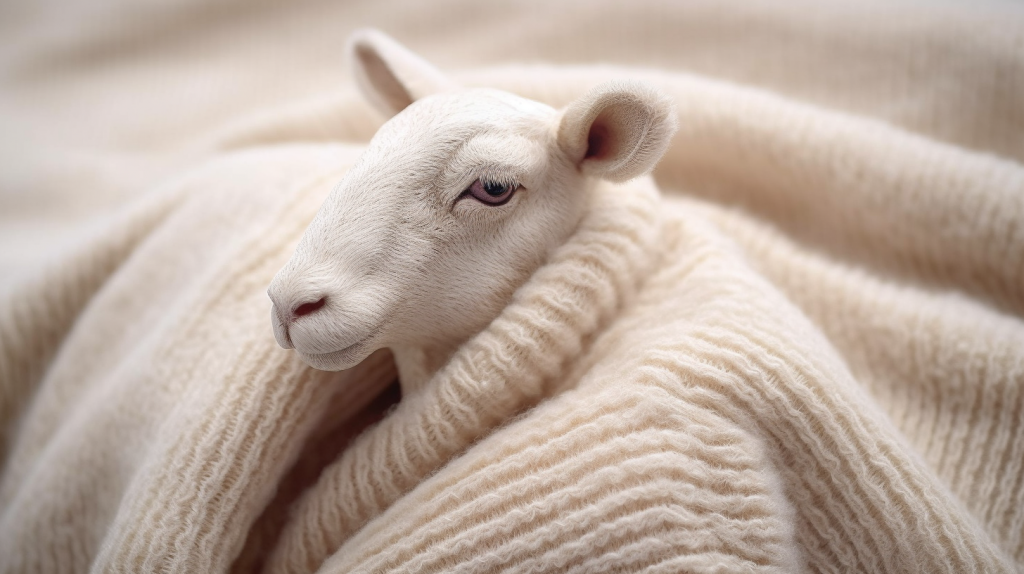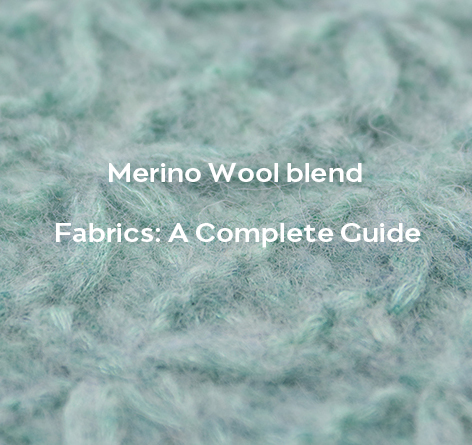Wholesalers looking to expand their sweater offerings often face a crucial decision: pure wool or wool blend? Both materials offer distinct advantages, and understanding these differences is key to building a successful wool sweater collection. This comprehensive guide dives into the world of wool and wool blends, equipping you with the knowledge to make informed choices for your brand.
Part I: Decoding Wool: The Natural Choice
Understanding different wool classifications can be beneficial as you explore pure wool options. For a comprehensive breakdown of various wool types, their properties, and how they influence sweater characteristics, we recommend referring to our previous blog post: “How to Find the Right Wool for Men’s Knitwear.” It details popular wool types like merino wool, lambswool, and cashmere, helping you make informed choices based on factors like fibre thickness, softness, and warmth.

1. Benefits of Pure Wool Sweaters:
Pure wool offers a unique combination of natural properties that have made it a beloved sweater material for centuries. 100% wool boasts an impressive range of natural benefits:
- Breathable Champion: Wool fibres excel at regulating temperature. Microscopic air pockets allow for excellent air circulation, keeping wearers comfortable and preventing overheating. This makes pure wool sweaters a great year-round option.
- Warmth Without Bulk: Wool’s natural insulating properties trap body heat effectively, providing exceptional warmth during colder months. This warmth comes without added bulk, making wool sweaters both comfortable and stylish.
- Odour Resistance Powerhouse: Unlike some synthetic fabrics, wool fibres naturally resist odour-causing bacteria. This allows wool sweaters to stay fresh longer, requiring less frequent washing [https://www.woolmark.com/]. A win for both your customers and the environment!
- Wrinkle Woes Be Gone: High-quality wool has a natural elasticity that helps it resist wrinkles and maintain its shape. This reduces the need for ironing, making pure wool sweaters a low-maintenance choice.
Beyond functionality, pure wool offers a luxurious feel and a beautiful drape that elevates any sweater. The natural softness and subtle lustre of wool add a touch of elegance to any outfit.
100% wool sweaters provide an unmatched combination of natural comfort, warmth, and breathability. They appeal to customers seeking a luxurious and eco-conscious option, perfect for everyday wear or layering. Their natural temperature regulation makes them a year-round favourite, keeping wearers comfortable during both crisp fall mornings and unexpectedly chilly summer evenings. For customers prioritizing sustainability, pure wool boasts eco-friendly credentials as a natural and biodegradable fibre.
2. Drawbacks to Consider:
While pure wool boasts impressive benefits, it’s essential to be aware of some potential drawbacks:
- Itch Factor: Certain types of wool, particularly those with thicker fibers like some lamb’s wool varieties, can be itchy for some people. However, finer wools like merino wool are known for their softness and are less likely to cause irritation.
- Shrinkage Risk: Improper care can lead to shrinkage in pure wool sweaters. Following recommended washing and drying instructions (often hand-washing and drying flat) is essential to maintain the shape and size of your wool sweaters.
- Cost Consideration: Pure wool can be more expensive than some wool blends, especially for high-quality types like merino wool. Understanding your target audience’s budget is crucial when deciding how heavily to incorporate pure wool into your sweater collection.
By understanding both the advantages and disadvantages of pure wool, you can make informed choices for your brand and cater to your specific customer base.
Part II: The Power of Blends: Expanding Your Options in the Wool Sweater Market
Pure wool offers undeniable advantages, but the world of wool sweaters extends far beyond. Wool blends, combining wool’s natural benefits with synthetic fibres’ functionalities, provide wholesalers with a broader range of options to cater to diverse customer needs, including the high-end market. Here’s a look at some popular wool blend materials and how they can enhance your sweater collection:
1. Common Wool Blends:
Let’s delve into some popular wool blend options, offering a range of functionalities to suit various customer needs:
- Wool-Nylon: This dynamic duo offers a winning combination of warmth and durability. Wool contributes its natural insulating properties, while nylon adds strength and resilience. This blend is an excellent choice for sweaters that require frequent washing or are intended for activewear. However, breathability might be slightly reduced compared to pure wool.
- Wool-Polyester: Similar to wool-nylon, this blend prioritizes durability and wrinkle resistance. Polyester fibres enhance the shape retention of the sweater, making them ideal for everyday wear. Breathability can also be a consideration with this blend.
- Wool-Cotton: This blend offers a softer feel and improved breathability compared to other blends. The addition of cotton makes the sweaters more comfortable against the skin and provides a softer feel and enhanced breathability for everyday comfort. The cotton component makes the sweaters feel gentle against the skin, perfect for customers seeking a cosy and casual option. These blends can also be a good choice for those who find pure wool slightly itchy. However, it might not be as warm or wrinkle-resistant as pure wool or other wool blends.
- Wool-Acrylic: This blend offers a balance of affordability, warmth, and softness. Acrylic fibres enhance the shape retention and wrinkle resistance of sweaters, making them a good choice for everyday wear. However, breathability might be slightly reduced compared to pure wool or other wool blends containing natural fibres like cotton [1]. This blend can be a suitable option for customers looking for a more affordable alternative to pure wool while still maintaining some of the wool’s natural warmth.
2. Beyond Durability: Advantages of Wool Blends:
While durability is a crucial benefit of wool blends, they offer additional advantages for wholesalers:
- Cost-Effectiveness: Wool blends are generally more affordable than pure wool, especially for higher-quality wool types like merino wool. This allows you to offer a more comprehensive price range and cater to a budget-conscious market segment.
- Versatility in Design: The varying properties of different blends open doors for creative design possibilities. You can offer a range of textures, weights, and functionalities within your wool sweater collection.
- Care Convenience: Some wool blends, particularly those with a higher percentage of synthetic fibers, might be easier to care for than pure wool. Always check the care label for specific instructions, but some blends might allow for machine washing, making them a low-maintenance option for busy customers.
3. High-End Options: Blends for the Discerning Customer:
In addition to the blends mentioned above, the world of wool offers luxurious options for the high-end market:
- Merino Wool-Cashmere: This luxurious blend combines the superior softness of cashmere with the warmth and functionality of merino wool. Cashmere fibers are known for their exceptional fineness and warmth-to-weight ratio, making sweaters incredibly soft and lightweight. This blend elevates your collection and caters to customers seeking unparalleled comfort and luxury.
- Wool-Silk: This opulent blend offers a unique combination of breathability, drape, and a subtle sheen. Silk fibers add a touch of luxury and enhance the drape of the sweater, creating a more elegant silhouette. This blend is ideal for dressier sweaters or those seeking a sophisticated everyday look.
Offering a variety of wool blends alongside pure wool allows you to cater to a broader customer base and cater to different preferences.
Part III: Choosing the Right Material for Your Brand

Selecting the perfect material for your wool sweater collection hinges on two key factors: understanding your target audience and aligning with your brand identity. Let’s delve into these elements to guide your decision-making process.
- Decoding Your Audience and Brand:
- Target Audience: Understanding your ideal customer is paramount. Consider factors like;
Lifestyle: Are they seeking comfortable everyday sweaters or performance-driven activewear? Wool blends with enhanced durability, like wool-nylon, might be ideal for active lifestyles, while pure wool offers natural breathability for everyday wear.
Budget: Are they prioritizing affordability or willing to invest in premium materials? Wool blends are generally more cost-effective than pure wool, especially for high-quality wool types like merino wool. This allows you to cater to a broader price range.
Preferences: Do they prioritize natural materials or value features like wrinkle resistance and easy care? Pure wool offers a luxurious feel, but might require more delicate care compared to some wool blends.

- Brand Identity: Your brand values should also influence material selection:
Focus on Sustainability: If your brand emphasizes natural and sustainable materials, pure wool aligns perfectly. However, some wool blends made with recycled synthetic fibers can also be a sustainable option [https://apparelcoalition.org/]. Contact us for further wool blend solutions.
Offering Versatility: Do you cater to a diverse customer base with varying needs? Consider offering a range of options, including both pure wool and wool blends. This allows customers to choose based on their priorities and budget.
Luxury Experience: If your brand focuses on high-end garments, explore luxurious wool blends like merino wool-cashmere for unparalleled softness or wool-silk for a touch of elegance.
2. Building a Diverse Wool Sweater Collection:
The true strength lies in offering a variety. By incorporating both pure wool and strategically chosen wool blends, you cater to a wider audience and cater to a broader range of needs:
- Pure wool sweaters provide an unmatched combination of natural comfort, warmth, and breathability, appealing to customers seeking a luxurious and eco-conscious option.
- Wool blend offers a wider range of functionalities. Wool-nylon blends prioritize durability for active lifestyles, while wool-cotton blends provide a softer feel for everyday comfort. Wool blends can also be more affordable, allowing you to cater to a budget-conscious customer segment.
A diverse wool sweater collection that considers both pure wool and wool blends allows you to cater to a broader audience and maximize your sales potential.




